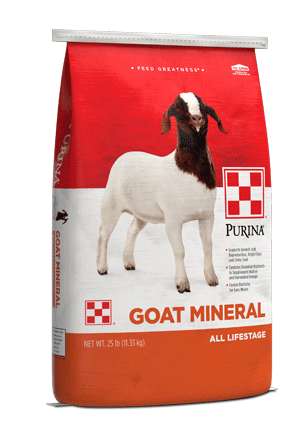
Better Breeding Season Starts with Goat Body Condition Score
Wellness : Health

It's easy to overlook goat body condition score (BCS) during the summer months. Your does have what they need to be self-sufficient until it's time to turn the bucks out again: fresh air, plenty of pasture, water and likely access to a free-choice goat mineral supplement.
But goat breeding season arrives sooner than you think. Make sure to give does more than a passing glance during the summer months to make sure they are in good condition for successful pregnancies.
At 45 to 60 days before the beginning of the goat breeding season, doe BCS should be 2.5 to 3.0 for optimal breeding and conception results. Maintaining body condition scores, or improving those for thin does, during the first 90 days of pregnancy helps promote embryo survival.
Too-thin does (1.5 BCS or below) may not only be weaker and more susceptible to disease, but they also typically take longer to conceive during breeding season. That’s because under-conditioned does may skip heat cycles until they get back to ideal weight.
Over-conditioned does (4.5 BCS or above) are also not reproductively or financially efficient. These females tend to take longer to breed, leading to delayed kidding and reduced kid gain.
Ideally, supplements should be offered year-round to maintain BCS through every season. It’s especially important to provide supplemental fat when forage nutrient values are declining through late summer, fall and winter.
As a doe gets later into gestation, her rumen competes for space with the growing kids. An energy-dense supplement provides the nutrition the doe needs in a smaller package, allowing her plenty of space for both the rumen and kids.
Once kids are born, maternal nutrition remains important. A higher level of dietary fat can influence milk fat content. In turn, higher milk fat helps kids get a better start with extra energy for rapid and efficient kid growth.
Start today by zeroing in on doe BCS to ensure your herd is ready for the breeding season. Download the BCS chart as a tool to monitor herd performance.
But goat breeding season arrives sooner than you think. Make sure to give does more than a passing glance during the summer months to make sure they are in good condition for successful pregnancies.
Evaluate goat body condition scores
Use a BCS chart to assess your herd's condition. Depending on herd size, it may not be practical to check the condition of all does. In that case, score approximately 10-20% of does to get an estimate of the herd’s condition.At 45 to 60 days before the beginning of the goat breeding season, doe BCS should be 2.5 to 3.0 for optimal breeding and conception results. Maintaining body condition scores, or improving those for thin does, during the first 90 days of pregnancy helps promote embryo survival.
Too-thin does (1.5 BCS or below) may not only be weaker and more susceptible to disease, but they also typically take longer to conceive during breeding season. That’s because under-conditioned does may skip heat cycles until they get back to ideal weight.
Over-conditioned does (4.5 BCS or above) are also not reproductively or financially efficient. These females tend to take longer to breed, leading to delayed kidding and reduced kid gain.
Hit the body condition score target
To hit a target BCS of 2.5 to 3.0, consider adding a supplemental fat and protein source. Supplemental fat can help maintain condition and is especially important if does trend toward the thin side. Fat has 2.5 times more energy than a carbohydrate like corn, making it the most efficient way to add energy into a diet.Ideally, supplements should be offered year-round to maintain BCS through every season. It’s especially important to provide supplemental fat when forage nutrient values are declining through late summer, fall and winter.
Kids win too
Supplementation is critical as does enter the third trimester, when 75% of fetal growth occurs. If the doe can't get enough energy into her system during this timeframe, she can lose condition since the fetus is taking many of the nutrients.As a doe gets later into gestation, her rumen competes for space with the growing kids. An energy-dense supplement provides the nutrition the doe needs in a smaller package, allowing her plenty of space for both the rumen and kids.
Once kids are born, maternal nutrition remains important. A higher level of dietary fat can influence milk fat content. In turn, higher milk fat helps kids get a better start with extra energy for rapid and efficient kid growth.
Start today by zeroing in on doe BCS to ensure your herd is ready for the breeding season. Download the BCS chart as a tool to monitor herd performance.


